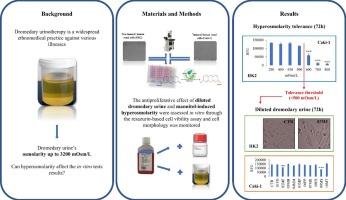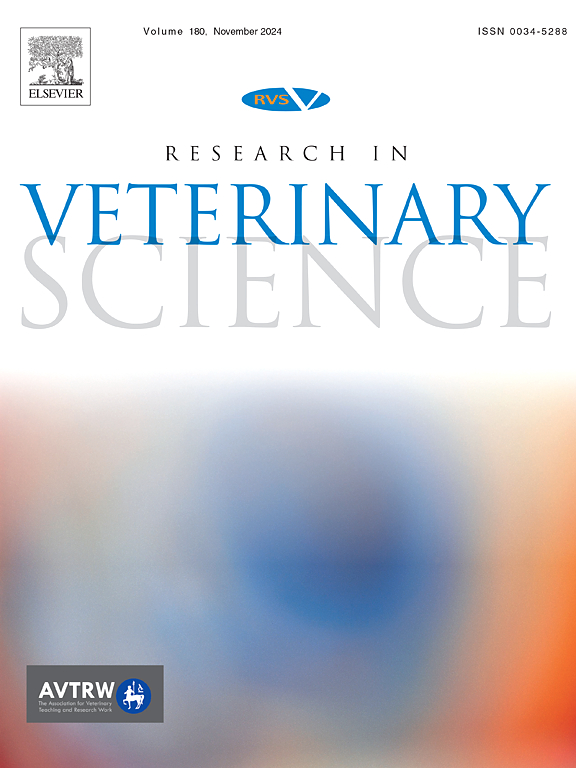影响天然基质生物活性的因素:不同稀释度的骆驼尿液对细胞活力的渗透调节作用
IF 2.2
3区 农林科学
Q1 VETERINARY SCIENCES
引用次数: 0
摘要
在传统的单峰骆驼国家,以单峰骆驼尿疗法治疗包括癌症在内的各种疾病的做法非常普遍。研究人员试图通过体外实验证明骆驼尿的抗癌特性,但结果却存在争议。值得注意的是,在这些实验中,有两个关键方面仍未得到探讨:(i) 测试尿液的渗透压,这会对体外实验结果产生重大影响;(ii) 细胞暴露于骆驼尿液后的潜在形态变化。在本研究中,我们通过评估渗透压对人肾脏细胞系细胞活力的影响,弥补了上述不足。为此,我们评估了高渗透甘露醇溶液和单峰驼尿液对人类非肿瘤肾细胞(HK2)和肿瘤肾细胞(Caki-1)的活力和形态的影响。结果表明,只有当甘露醇诱导的高渗透压低于 500 mOsm/L 时,HK2 和 Caki-1 细胞的活力和形态才不会受到明显影响。值得注意的是,当暴露于稀释到 500 mOsm/L 的尿液中时,主要在 Caki-1 细胞中观察到了统计学意义上的显著抗增殖效应(在 10 个测试尿液样本中,有 2 个存在这种效应)。相反,当暴露于同样稀释的骆驼尿液时,只在 HK2 细胞中观察到细胞形态的改变。为了从分子水平研究观察到的抗增殖效应,我们对测试尿样进行了初步的代谢组学分析,以确定潜在的生物活性化合物。核磁共振(NMR)代谢分析表明存在三种抗氧化化合物,即三尖杉碱、丙酮酸和 N-乙酰葡糖胺。总之,我们的研究结果突出表明,在体外评估骆驼尿液的生物活性特性时,考虑渗透压的关键作用非常重要。相反,可以考虑将骆驼尿作为生物活性化合物来源的可能性。本文章由计算机程序翻译,如有差异,请以英文原文为准。

Factors influencing the bioactivity of natural matrices: The case of osmolarity-dependent modulation of cell viability by different dilutions of camel urines
The widespread practice of dromedary urinotherapy as a remedy for various illnesses, including cancer, is well-established in traditional dromedary countries. Researchers attempted to demonstrate anticancer properties of camel urine through in vitro experiments with debated outcomes. Notably, two critical aspects remained unexplored in those assays: (i) the osmolarity of tested urines, which can significantly influence in vitro results; (ii) the potential morphological changes of cells, following exposure to camel urines. In this study, we addressed these gaps by evaluating the osmolarity-dependent modulation of cell viability in human renal cell lines. In this regard, we assessed the impact of hyperosmolar mannitol-based solutions and dromedary urine on the viability and morphology of human non-tumor (HK2) and tumor renal cells (Caki-1). The results indicate that cell viability or morphology in both HK2 and Caki-1 cells are not significantly affected only if mannitol-induced hyperosmolarity is lower than 500 mOsm/L. Notably, when exposed to urine solution, diluted to <500 mOsm/L, statistically significant antiproliferative effects were observed primarily in Caki-1 cells (in presence of two out of ten tested urine samples). Conversely, alterations in cell morphology were observed exclusively in HK2 cells when exposed to the same diluted camel urines. In order to investigate, at molecular level, the observed antiproliferative effects, a preliminary metabolomics analysis of the tested urine samples was performed to identify potential bioactive compounds. The Nuclear Magnetic Resonance (NMR) metabolic profiling revealed the presence of three antioxidant compounds, namely trigonelline, pyruvic acid and N-acetylglucosamine. In conclusion, our results highlight the importance of considering the critical role of osmolarity when evaluating the bioactive properties of camel urine in vitro, which should not be used to treat any illness as it is. Conversely, it can be considered the possibility to use camel urines as a source of bioactive compounds.
求助全文
通过发布文献求助,成功后即可免费获取论文全文。
去求助
来源期刊

Research in veterinary science
农林科学-兽医学
CiteScore
4.40
自引率
4.20%
发文量
312
审稿时长
75 days
期刊介绍:
Research in Veterinary Science is an International multi-disciplinary journal publishing original articles, reviews and short communications of a high scientific and ethical standard in all aspects of veterinary and biomedical research.
The primary aim of the journal is to inform veterinary and biomedical scientists of significant advances in veterinary and related research through prompt publication and dissemination. Secondly, the journal aims to provide a general multi-disciplinary forum for discussion and debate of news and issues concerning veterinary science. Thirdly, to promote the dissemination of knowledge to a broader range of professions, globally.
High quality papers on all species of animals are considered, particularly those considered to be of high scientific importance and originality, and with interdisciplinary interest. The journal encourages papers providing results that have clear implications for understanding disease pathogenesis and for the development of control measures or treatments, as well as those dealing with a comparative biomedical approach, which represents a substantial improvement to animal and human health.
Studies without a robust scientific hypothesis or that are preliminary, or of weak originality, as well as negative results, are not appropriate for the journal. Furthermore, observational approaches, case studies or field reports lacking an advancement in general knowledge do not fall within the scope of the journal.
 求助内容:
求助内容: 应助结果提醒方式:
应助结果提醒方式:


